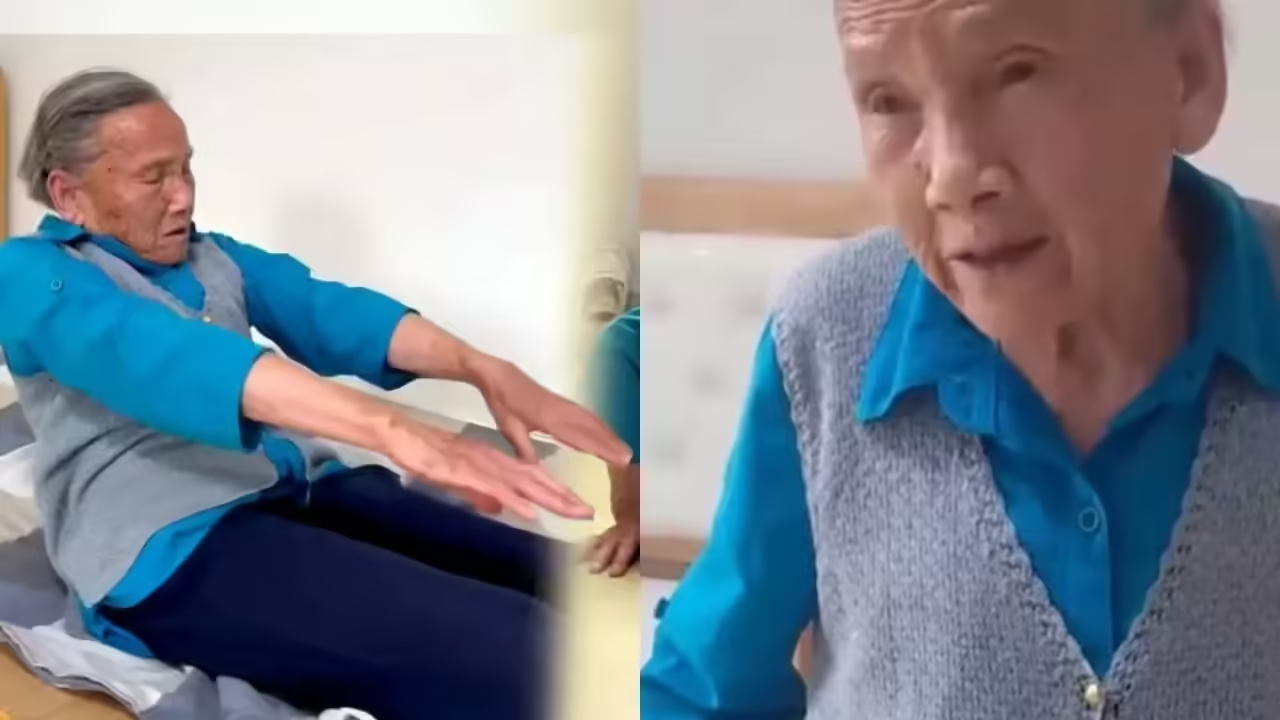New York: In an era where discussions about healthy aging, fitness trends, and longevity dominate social media, an unlikely role model has emerged from China—a 92-year-old grandmother who performs 200 push-ups and 100 sit-ups every single day. Her story has captivated millions online, not just for the sheer physical endurance but for how it challenges long-standing stereotypes about old age, fitness, and the boundaries of human capability.
The viral sensation of this elderly fitness enthusiast has become more than a feel-good story. It’s a conversation starter about health habits, discipline, aging gracefully, and how society views its senior citizens. Let’s take a deep dive into her daily routine, explore the science behind senior fitness, and analyze the global conversation sparked by her incredible lifestyle.
How the Story Went Viral
Social media thrives on inspiring content, and nothing grabs attention quite like stories that defy expectations. The grandmother’s video clips first circulated through local Chinese media outlets before spreading internationally via platforms like TikTok, YouTube, and Weibo. Viewers were mesmerized by her stamina and agility, leaving comments ranging from astonishment to admiration.
Her story illustrates how virality often stems from contrast—a nonagenarian accomplishing something usually associated with professional athletes or young soldiers. At a time when health discussions are often clouded by declining fitness rates among younger people, this grandmother provided a striking reminder of what’s possible with discipline and consistency.
Daily Routine That Shocked the Internet
Unlike many fitness influencers, the grandmother doesn’t rely on fancy gym memberships or high-tech equipment. Instead, her daily formula revolves around bodyweight exercises that anyone can do at home.
Key elements of her daily workout
-
Push-ups: 200 reps, broken down into multiple sets
-
Sit-ups: 100 reps as core strengthening exercises
-
Morning walks around her neighborhood
-
Balanced diet with traditional Chinese nutrition patterns
-
Adequate rest and consistent sleep routines
Routine Consistency
What impressed viewers most was not just the number of repetitions but the fact that she does this every single day. Maintaining such regularity in her nineties makes her a case study in discipline.
Why Netizens Are Impressed
The grandmother’s routine resonates with audiences for several reasons:
-
She breaks cultural stereotypes about aging and fragility.
-
Social media users see her as proof that longevity doesn’t have to mean physical decline.
-
Her workout is relatable; anyone with determination and no equipment can start.
-
She comes across authentic—no sponsorships, just commitment.
In a society obsessed with anti-aging products, skincare routines, and medical shortcuts, her natural approach to health feels refreshing and genuine.
Benefits of Push-Ups and Sit-Ups for Seniors
To understand the significance of her routine, it’s important to evaluate the benefits of these exercises—especially at her age.
Push-Ups for Upper Body Strength
Push-ups are full-body compound exercises that strengthen muscles in the chest, shoulders, arms, and even core. For seniors, this helps:
-
Improve posture
-
Aid in daily activities like lifting or pushing
-
Reduce the risk of muscular degeneration
Sit-Ups for Core Stability
Sit-ups strengthen abdominal muscles and stabilize the spine. In seniors, core strength is directly linked to:
-
Better balance and fall prevention
-
Enhanced walking stability
-
Lower back support
The Science of Longevity and Muscle Retention
Health research consistently emphasizes two key ideas: exercise slows down aging, and consistent training preserves muscle mass.
-
According to global health reports, adults over 65 lose about 3–8% of muscle mass per decade.
-
Resistance training, even at a light level, has been shown to counter this effect.
-
Seniors who exercise regularly exhibit better memory, reduced risk of heart diseases, and greater independence in daily living.
Her regimen, though extreme in numbers, aligns perfectly with global recommendations that encourage seniors to engage in strength and core exercises at least twice per week.
Stats on Senior Fitness Worldwide
The grandmother’s story highlights a gap in senior fitness globally. Statistics show a major contrast between average seniors and her extraordinary discipline:
| Category | Average Senior (Worldwide) | 92-year-old Grandma (China) |
|---|---|---|
| Daily push-ups | Few to none | 200 |
| Daily sit-ups | Rarely practiced | 100 |
| Weekly exercise consistency | 2–3 times a week (recommended) | 7 times per week |
| Functional independence rate | Declines after age 80 | Maintains high activity |
These figures underline just how remarkable her achievement is when compared to everyday reality for aging populations.
Cultural Dimensions: Aging in China vs The West
In many Asian cultures, discipline and longevity are tied to traditional wisdom. Unlike Western societies, where aging is often associated with dependency, many Chinese seniors practice routines like tai chi, morning walks, and functional physical exercises.
Her fame also reflects how Chinese seniors often emphasize community, diet, and daily mobility, which contrasts with sedentary lifestyles more common in Western seniors.
Social Media’s Role in Redefining Aging
Stories like hers underscore how digital platforms have become key enablers of cultural change. A generation ago, such a figure might have inspired only her family and local community. Today, thanks to virality, she inspires millions worldwide.
This has created a growing online discourse:
-
Should seniors be encouraged to adopt more physical activity?
-
Are governments doing enough to provide accessible fitness facilities for older adults?
-
How much can mindset influence longevity compared to genetics?
Lessons from the Grandma’s Lifestyle
Beyond the workout numbers, the key lesson lies in consistency and mindset. You don’t need to lift heavy weights or run marathons. Her philosophy revolves around routine, self-discipline, and purpose.
Other observable lessons include:
-
Age should not define your health capacity.
-
Nutrition and moderation matter just as much as workouts.
-
Starting small and building habits leads to long-term resilience.
Critics and Concerns
While most reactions are positive, some medical professionals caution against generalizing her achievements as a benchmark for all seniors.
-
Not every elderly person has the same joint health, heart condition, or bone density to attempt 200 push-ups.
-
Seniors are encouraged to consult a medical professional before starting intense exercises.
-
Overtraining in old age could risk injuries if not balanced with rest and proper diet.
Nevertheless, these criticisms do not undermine her personal success story—they simply emphasize that her case is exceptional.
Global Comparisons: Other Inspirational Seniors
The Chinese grandma isn’t alone. Across the globe, many elderly individuals have shattered expectations around aging.
Examples include:
-
A Japanese woman in her 80s who teaches yoga classes.
-
An American grandfather in his late 90s who runs annual marathons.
-
Indian seniors performing daily yoga and pranayama with surprising stamina.
The common thread? Consistency in movement, balanced lifestyles, and unwavering determination.
How Brands and Media Responded
Mainstream brands and health industries have noticed the online buzz. Several wellness brands have highlighted her story as an organic inspiration. This points to a potential marketing trend—brands moving away from aspirational models toward authentic senior figures who represent real resilience.
This phenomenon reflects a shift in digital marketing: authenticity beats perfection.
Broader Implications for Public Health
From a policy perspective, her story highlights something crucial—the potential of preventive healthcare through lifestyle choices. As countries grapple with aging populations, inspiring figures like her demonstrate how daily movement and habit formation could dramatically cut healthcare costs linked to age-related decline.
In nations where public health systems are stretched, promoting senior fitness could serve as a low-cost way of ensuring independence and improving life quality among elderly citizens.
How You Can Adapt Her Routine Safely
For those inspired, here are suggested steps to emulate aspects of her lifestyle safely:
-
Begin with simple routines—start with 5–10 push-ups or wall push-ups.
-
Break exercises into sets throughout the day rather than all at once.
-
Incorporate walking or light stretching daily.
-
Focus on nutrition with proteins, fibers, and reduced processed foods.
-
Prioritize sleep and mindful relaxation practices.
The Psychology of Never Giving Up
The biggest takeaway is mindset. The grandma embodies resilience, positivity, and sheer determination. A strong mental framework allows her to stick to her commitments daily, even at an age when most prefer comfort over activity.
Psychologists often stress the correlation between mental health and physical longevity. The mind drives the body, and her outlook represents how positivity can sustain demanding routines over decades.
Conclusion
A viral story of a 92-year-old Chinese grandmother doing 200 push-ups and 100 sit-ups daily is more than entertainment—it’s a blueprint for how discipline, lifestyle, and mindset can redefine aging. She challenges the narrative of fragility at advanced age and reminds us that health is built not in dramatic moments but in small, consistent choices made daily.
Her life sends a powerful message worldwide: it’s never too late to start, and age doesn’t have to mean decline. For communities, governments, and individuals, her story acts as both inspiration and motivation to embrace healthier, more active lives—one push-up at a time.












Leave a Reply